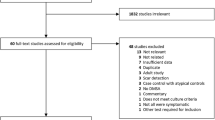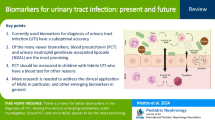Abstract
Background
To determine whether urine neutrophil gelatinase-associated lipocalin (uNGAL) might be superior to pyuria for detecting urinary tract infection (UTI) regardless of urine specific gravity (SG) in young children.
Methods
We conducted a retrospective analysis of children aged < 3 years who were evaluated for UTI with urinalysis, urine culture, and uNGAL measurements during a 5-year period. Sensitivity, specificity, likelihood ratios (LRs), predictive values (PVs), area under the curves (AUCs) of uNGAL cut-off levels, and various microscopic pyuria thresholds for detecting UTI were calculated for dilute (SG < 1.015) and concentrated urine (SG ≥ 1.015).
Results
Of 456 children included, 218 had UTI. The diagnostic value of urine white blood cell (WBC) concentration to define UTI changed with urine SG. For detecting UTI, uNGAL cut-off of 68.4 ng/mL had higher AUC values than pyuria ≥ 5 WBCs/high power field (HPF) for dilute and concentrated urine samples (both P < 0.05). Positive LR and PV and specificity of uNGAL were all greater than those of pyuria ≥ 5 WBCs/HPF regardless of urine SG, although the sensitivity of pyuria ≥ 5 WBCs/HPF was higher than that of uNGAL cut-off for dilute urine (93.8% vs. 83.5%) (P < 0.05). At uNGAL ≥ 68.4 ng/mL and ≥ 5 WBCs/HPF, posttest probabilities of UTI were 68.8% and 57.5% for dilute urine and 73.4% and 57.3% for concentrated urine, respectively.
Conclusions
Urine SG can affect the diagnostic performance of pyuria for detecting UTI and uNGAL might be helpful for identifying UTI regardless of urine SG in young children.
Graphical abstract

A higher resolution version of the Graphical abstract is available as Supplementary information


Similar content being viewed by others
Data availability
All data generated or analyzed during this study are included in this published article.
References
Chaudhari PP, Monuteaux MC, Bachur RG (2016) Urine concentration and pyuria for identifying UTI in Infants. Pediatrics 138:e20162370. https://doi.org/10.1542/peds.2016-2370
Liang T, Oraa SS, Rodriguez NR, Bagade T, Chao J, Sinert R (2021) Predicting urinary tract infections with interval likelihood ratios. Pediatrics 147:e2020015008. https://doi.org/10.1542/peds.2020-015008
Leung AKC, Wong AHC, Leung AAM, Hon KL (2019) Urinary tract infection in children. Recent Pat Inflamm Allergy Drug Discov 13:2–18. https://doi.org/10.2174/1872213x13666181228154940
Kim H, Suh JS, Bin JH, Lee SY (2022) Infectious inflammation in children with acute pyelonephritis. Child Kidney Dis 26:116–118. https://doi.org/10.3339/ckd.22.040
Kliegman RM, Behrman RE, Jenson HB, Stanton BM (2019) Nelson textbook of pediatrics. In: Jerardi KE, Jackson EC (eds) Urinary tract infections, 21th edn. Elsevier Health Sciences, Philadelphia, pp 2789–2794
Subcommittee on Urinary Tract Infection (2016) Reaffirmation of AAP clinical practice guideline: the diagnosis and management of the initial urinary tract infection in febrile infants and young children 2-24 months of age. Pediatrics 138:e20163026. https://doi.org/10.1542/peds.2016-3026
Stein R, Dogan HS, Hoebeke P, Kočvara R, Nijman RJ, Radmayr C, Tekgül S (2015) Urinary tract infections in children: EAU/ESPU guidelines. Eur Urol 67:546–558. https://doi.org/10.1016/j.eururo.2014.11.007
Shaikh N, Shope MF, Kurs-Lasky M (2019) Urine specific gravity and the accuracy of urinalysis. Pediatrics 144:e20190467. https://doi.org/10.1542/peds.2019-0467
Nadeem S, Badawy M, Oke OK, Filkins LM, Park JY, Hennes HM (2021) Pyuria and urine concentration for identifying urinary tract infection in young children. Pediatrics 147:e2020014068. https://doi.org/10.1542/peds.2020-014068
Chaudhari PP, Monuteaux MC, Shah P, Bachur RG (2017) The importance of urine concentration on the diagnostic performance of the urinalysis for pediatric urinary tract infection. Ann Emerg Med 70:63–71.e8. https://doi.org/10.1016/j.annemergmed.2016.11.042
Yilmaz A, Sevketoglu E, Gedikbasi A, Karyagar S, Kiyak A, Mulazimoglu M, Aydogan G, Ozpacaci T, Hatipoglu S (2009) Early prediction of urinary tract infection with urinary neutrophil gelatinase associated lipocalin. Pediatr Nephrol 24:2387–2392. https://doi.org/10.1007/s00467-009-1279-6
Kjeldsen L, Bainton DF, Sengeløv H, Borregaard N (1994) Identification of neutrophil gelatinase-associated lipocalin as a novel matrix protein of specific granules in human neutrophils. Blood 83:799–807
Vanmassenhove J, Glorieux G, Lameire N, Hoste E, Dhondt A, Vanholder R, Van Biesen W (2015) Influence of severity of illness on neutrophil gelatinase-associated lipocalin performance as a marker of acute kidney injury: a prospective cohort study of patients with sepsis. BMC Nephrol 16:18. https://doi.org/10.1186/s12882-015-0003-y
Paragas N, Kulkarni R, Werth M, Schmidt-Ott KM, Forster C, Deng R, Zhang Q, Singer E, Klose AD, Shen TH, Francis KP, Ray S, Vijayakumar S, Seward S, Bovino ME, Xu K, Takabe Y, Amaral FE, Mohan S, Wax R, Corbin K, Sanna-Cherchi S, Mori K, Johnson L, Nickolas T, D’Agati V, Lin CS, Qiu A, Al-Awqati Q, Ratner AJ, Barasch J (2014) α-Intercalated cells defend the urinary system from bacterial infection. J Clin Invest 124:2963–2976. https://doi.org/10.1172/jci71630
Jahaj E, Vassiliou AG, Pratikaki M, Gallos P, Mastora Z, Dimopoulou I, Orfanos SE, Orfanos P, Lagiou P, Kotanidou A (2021) Serum neutrophil gelatinase-associated lipocalin (NGAL) could provide better accuracy than creatinine in predicting acute kidney injury development in critically ill patients. J Clin Med 10:5379. https://doi.org/10.3390/jcm10225379
Lubell TR, Barasch JM, Xu K, Ieni M, Cabrera KI, Dayan PS (2017) Urinary neutrophil gelatinase-associated lipocalin for the diagnosis of urinary tract infections. Pediatrics 140:e20171090. https://doi.org/10.1542/peds.2017-1090
Son MH, Yim HE, Yoo KH (2021) Plasma neutrophil gelatinase-associated lipocalin and leukocyte differential count in children with febrile urinary tract infection. Child Kidney Dis 25:84–91. https://doi.org/10.3339/jkspn.2021.25.2.84
Jagadesan I, Agarwal I, Chaturvedi S, Jose A, Sahni RD, Fleming JJ (2019) Urinary neutrophil gelatinase associated lipocalin – a sensitive marker for urinary tract infection in children. Indian J Nephrol 29:340–344. https://doi.org/10.4103/ijn.IJN_276_18
Shaikh K, Rajakumar V, Osio VA, Shaikh N (2021) Neutrophil gelatinase-associated lipocalin for urinary tract infection and pyelonephritis: a systematic review. Pediatr Nephrol 36:1481–1487. https://doi.org/10.1007/s00467-020-04854-3
Yim HE, Yim H, Bae ES, Woo SU, Yoo KH (2014) Predictive value of urinary and serum biomarkers in young children with febrile urinary tract infections. Pediatr Nephrol 29:2181–2189. https://doi.org/10.1007/s00467-014-2845-0
Kim BK, Yim HE, Yoo KH (2017) Plasma neutrophil gelatinase-associated lipocalin: a marker of acute pyelonephritis in children. Pediatr Nephrol 32:477–484. https://doi.org/10.1007/s00467-016-3518-y
Lee JH, Yim HE, Yoo KH (2020) Associations of plasma neutrophil gelatinase-associated lipocalin, anemia, and renal Scarring in children with febrile urinary tract infections. J Korean Med Sci 35:e65. https://doi.org/10.3346/jkms.2020.35.e65
Moon JH, Yoo KH, Yim HE (2021) Urinary neutrophil gelatinase-associated lipocalin: a marker of urinary tract infection among febrile children. Clin Exp Pediatr 64:347–354. https://doi.org/10.3345/cep.2020.01130
Whiting P, Westwood M, Watt I, Cooper J, Kleijnen J (2005) Rapid tests and urine sampling techniques for the diagnosis of urinary tract infection (UTI) in children under five years: a systematic review. BMC Pediatr 5:4. https://doi.org/10.1186/1471-2431-5-4
Gorelick MH, Shaw KN (1999) Screening tests for urinary tract infection in children: a meta-analysis. Pediatrics 104:e54. https://doi.org/10.1542/peds.104.5.e54
Roberts KB (2011) Urinary tract infection: clinical practice guideline for the diagnosis and management of the initial UTI in febrile infants and children 2 to 24 months. Pediatrics 128:595–610. https://doi.org/10.1542/peds.2011-1330
García-Nieto V, González-Cerrato S, Luis-Yanes MI, Monge-Zamorano M, Reyes-Millán B (2014) Decreased concentrating capacity in children with febrile urinary tract infection and normal 99mTc-dimercaptosuccinic acid scan: does medullonephritis exist? World J Pediatr 10:133–137. https://doi.org/10.1007/s12519-014-0482-0
Stattin Norinder B, Sandberg T, Norrby R (2005) Renal concentrating capacity in female outpatients with symptomatic urinary tract infection. Scand J Urol Nephrol 39:483–487. https://doi.org/10.1080/00365590500342950
Sterner G (1991) Renal concentration capacity in adult patients with urinary tract infections. Scand J Urol Nephrol 25:219–222. https://doi.org/10.3109/00365599109107950
Schmidt-Ott KM, Mori K, Li JY, Kalandadze A, Cohen DJ, Devarajan P, Barasch J (2007) Dual action of neutrophil gelatinase-associated lipocalin. J Am Soc Nephrol 18:407–413. https://doi.org/10.1681/asn.2006080882
Jang JW, Yim HE, Yoo KH (2020) Association of neutrophil gelatinase associated lipocalin and leukocyte differential count in children with febrile urinary tract infections. Child Kidney Dis 24:83–90. https://doi.org/10.3339/jkspn.2020.24.2.83
Shaikh N, Liu H, Kurs-Lasky M, Forster CS (2022) Biomarkers for febrile urinary tract infection in children. Pediatr Nephrol 37:171–177. https://doi.org/10.1007/s00467-021-05173-x
Decavele AS, Dhondt L, De Buyzere ML, Delanghe JR (2011) Increased urinary neutrophil gelatinase associated lipocalin in urinary tract infections and leukocyturia. Clin Chem Lab Med 49:999–1003. https://doi.org/10.1515/cclm.2011.156
Abbasi A, Nabizadeh F, Gardeh M, Mohamed Ali K, Yousefifard M, Hosseini M (2020) Discriminatory precision of neutrophil gelatinase-associated lipocalin in detection of urinary tract infection in children: a systematic review and meta-analysis. Arch Acad Emerg Med 8:e56. https://www.ncbi.nlm.nih.gov/pubmed/32440667
Cowland JB, Sørensen OE, Sehested M, Borregaard N (2003) Neutrophil gelatinase-associated lipocalin is up-regulated in human epithelial cells by IL-1 beta, but not by TNF-alpha. J Immunol 171:6630–6639. https://doi.org/10.4049/jimmunol.171.12.6630
Playford RJ, Belo A, Poulsom R, Fitzgerald AJ, Harris K, Pawluczyk I, Ryon J, Darby T, Nilsen-Hamilton M, Ghosh S, Marchbank T (2006) Effects of mouse and human lipocalin homologues 24p3/lcn2 and neutrophil gelatinase-associated lipocalin on gastrointestinal mucosal integrity and repair. Gastroenterology 131:809–817. https://doi.org/10.1053/j.gastro.2006.05.051
Flo TH, Smith KD, Sato S, Rodriguez DJ, Holmes MA, Strong RK, Akira S, Aderem A (2004) Lipocalin 2 mediates an innate immune response to bacterial infection by sequestrating iron. Nature 432:917–921. https://doi.org/10.1038/nature03104
Chen CN, Chou CH, Jeng SF, Tsai IJ, Chen PC, Chen CY, Chou HC, Tsao PN, Hsieh WS (2016) Urinary neutrophil gelatinase-associated lipocalin levels in neonates. Pediatr Neonatol 57:207–212. https://doi.org/10.1016/j.pedneo.2015.09.003
Brown MD, Reeves MJ (2003) Evidence-based emergency medicine/skills for evidence-based emergency care. Interval likelihood ratios: another advantage for the evidence-based diagnostician. Ann Emerg Med 42:292–297. https://doi.org/10.1067/mem.2003.274
Deeks JJ, Altman DG (2004) Diagnostic tests 4: likelihood ratios. BMJ 329:168–169. https://doi.org/10.1136/bmj.329.7458.168
Mariottoni EB, Jammal AA, Berchuck SI, Shigueoka LS, Tavares IM, Medeiros FA (2021) An objective structural and functional reference standard in glaucoma. Sci Rep 11:1752. https://doi.org/10.1038/s41598-021-80993-3
Becknell B, Schober M, Korbel L, Spencer JD (2015) The diagnosis, evaluation and treatment of acute and recurrent pediatric urinary tract infections. Expert Rev Anti Infect Ther 13:81–90. https://doi.org/10.1586/14787210.2015.986097
Acknowledgments
This work was supported by a Korea University Grant (No. K1912741). We also would like to express our gratitude to Professor Hang Seok Choi (Medical Science Research Center, Korea University College of Medicine) for statistical advice.
Author information
Authors and Affiliations
Contributions
Dr. Hyung Eun Yim contributed to the study conception, study design, and project administration. Material preparation and data collection were performed by Do Young Kim, Hyung Eun Yim, and Kee Hwan Yoo. Statistical analyses were performed by Do Young Kim. Visualization was produced by Do Young Kim and Min Hwa Son. The first draft of the manuscript was written by Do Young Kim. It was reviewed and revised by Do Young Kim, Hyung Eun Yim, Min Hwa Son, and Kee Hwan Yoo. All authors read and approved the final manuscript.
Corresponding author
Ethics declarations
Authors have no financial interests that are directly or indirectly related to the work submitted here for publication.
Ethics statement
This study was approved by our Institutional Review Board (IRB) before initiation (Korea University Guro Hospital, IRB number: 2018GR0321). The IRB waived the requirement to obtain informed consent since this study involved a retrospective chart review of anonymous patient data. This study was carried out in accordance with the Declaration of Helsinki. Patients' data from our previous papers [23, 31] were partially included.
Additional information
Publisher’s note
Springer Nature remains neutral with regard to jurisdictional claims in published maps and institutional affiliations.
Supplementary Information
Below is the link to the electronic supplementary material.
Rights and permissions
Springer Nature or its licensor (e.g. a society or other partner) holds exclusive rights to this article under a publishing agreement with the author(s) or other rightsholder(s); author self-archiving of the accepted manuscript version of this article is solely governed by the terms of such publishing agreement and applicable law.
About this article
Cite this article
Kim, D.Y., Yim, H.E., Son, M.H. et al. Urine specific gravity, pyuria, and neutrophil gelatinase-associated lipocalin for identifying urinary tract infection in young children. Pediatr Nephrol 38, 3337–3346 (2023). https://doi.org/10.1007/s00467-023-05957-3
Received:
Revised:
Accepted:
Published:
Issue Date:
DOI: https://doi.org/10.1007/s00467-023-05957-3




